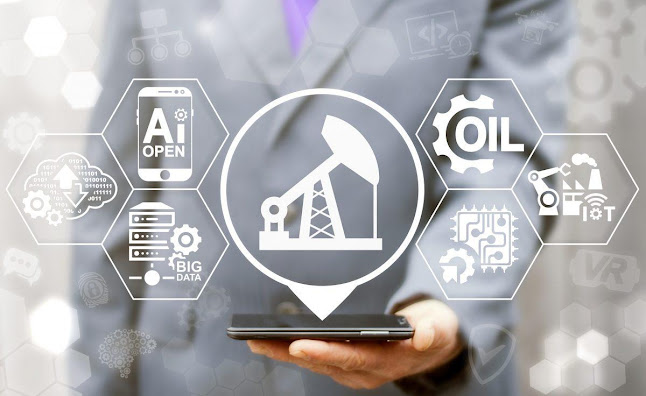The Covid-19 pandemic has boosted the pre-existing imbalance between demand and supply in the oil and gas (O&G) industry. This disruption has resulted in financial loss, forcing companies to reduce costs, including reductions in workforce and salaries.
Another threat is the competition from the renewable energy industry, which is estimated to be valued at $1.25 trillion by 2028. The oil and gas sector intends to leverage digital transformation to overcome these problems and remain stable in industry. This article will highlight the top five digital technologies and how they are transforming the oil and gas industry.
Also Read: Here are some Reasons to Host a Hybrid Event!
1)- AI and data science in O&G
Modern analytics: Big data and AI (Artificial Intelligence) can enable strong analytics platforms to provide report for improved operational and managerial efficiency to reduce disruptions across the oil and gas supply chain. Advanced analytics are getting combined with cloud software to give significant infrastructure cost savings.

Seismic data: During location search for oil drilling, advanced analytics can study seismic data to provide risk insights, increasing the success rate and saving time and money. Seismic data analytics can also be merged with historical data to identify oil levels in reservoirs. Predictive maintenance: Big data gathered from expensive machines working on offshore drilling platforms can be used for predictive maintenance of assets and reducing failures.
2)- Industrial Iot in O&G
Regular Monitoring of pipelines: Leaks and damages in oil and gas extraction can effect significant financial and environmental damage. Iot (Internet of Things) can allow efficient checking of pipes, pumps, and filters in the system with real-time data to avoid these leaks. This cuts unnecessary manual checks of the system, and workers are only deployed when anomalies are detected. Asset Monitoring: Iot-enabled sensors can impact remote access to usage and maintenance data of heavy machines installed in offshore drilling that are stored in remote areas with extreme conditions.

IoT in oil refineries: IoT-enabled sensors can give real-time data to control performance parameters. As a result, real-time data is available around the clock to show accurate measurements. Oil and Gas Logistics: Since oil and gas-containing ships are huge, some areas are inaccessible. LPWANs (Low-power wide-area networks) provide continuous monitoring capability to the workers on the ship with real-time data for maintenance.
3)- Automation in O&G
According to Research global market value of automation technology in the oil and gas market is projected to almost gets doubled and reach around $52 billion by 2032. The implications of automation in the oil and gas sector are: RPA & Intelligent automation: Automating the closing process through RPA (Robotics Process Automation) can manually reduce closing time, reduce the risk of human errors and improve audibility in the oil and gas sector. Automated O&G supply chains: Through RPA, procurement transactions can be performed automatically to improve cycle times and achieve overall efficiency in oil and gas supply chains.
Drones in offshore drilling: Drones and submersible bots are used to automate the inspection of inaccessible areas in offshore drilling. Bots can also reduce errors and increase workers safety while installing new parts and repairing existing ones in risky locations.
4)- AR and VR in O&G
The AR (Augmented Reality) and VR (Virtual reality) market is estimated to increase 10 times to ~$300 billion by 2026. The implementations of AR and VR in the oil and gas sector are. Advanced training: VR headsets can provide practical training to workers without the need to visit offshore plants. This can provide an efficient and safer way of applying theoretical knowledge in practical cases and in an easy manner also. Advanced maintenance: AR headsets can provide hands-free instruction steps and relevant tools and parts.
This can usually increase maintenance efficiency, providing graphical information and eliminating the need for reading lengthy manuals. Additionally, these AR headsets can also provide live video access to technicians who are not available at the maintenance location and also record the process for the future.
5)- Blockchain in O&G
The implication of blockchain technology in the oil and gas sector are: Secure O&G transactions: Through blockchain technology, digital transactions are performed with higher transparency and an advanced level security. For example, Natixis, IBM, and Trafigura signed a smart contract platform based on blockchain for the USA to manage crude oil deals securely.
IBM has also provided a detailed report on a shareable ledger system based on SAP that is helping in improved visibility and efficiency in daily transactions performed for the oil and gas sector. Increased trust: Blockchain technology can allow the storage and authentication of certificates of recruitment training. It can also increase transparency between business partners regarding sustainability and ethical practices. To learn more about how digital technologies are transforming different sectors.
6)- Data Business in Oil & Gas Market
The data business in oil & gas market is likely to be valued at US$ 31.6 Bn in 2022 and is projected to reach US$ 145.9 Bn by 2032.
“Oil and gas companies have been able to operate efficiently in a low-cost environment by implementing and utilizing real-time analytics and predictive analytics systems. This has allowed them to focus on operating costs and capital expenditure.”
The rise in popularity of real-time analysis and predictive analytics solutions, and the spike in the number of cyber-attacks and data breaches are among the key factors driving the data business in oil & gas market growth.



More Stories
ATAS: Revolutionizing Trading and Investing Through Advanced Technology
How to Use Technology to Boost Your Business Organization
Best CCTV Cameras to Secure Your Home